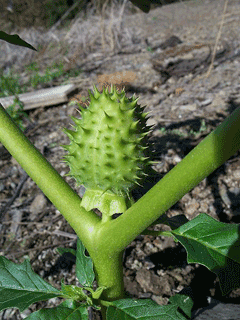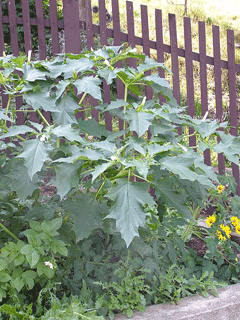 |
|
http://commons.wikimedia.org/wiki/User:EugeneZelenko |
 |
| http://commons.wikimedia.org/wiki/User:Daniel_Bar%C3%A1nek |
Translate this page:
Summary
Bloom Color: Purple, White.
Main Bloom Time: Early summer, Early fall, Late summer, Mid summer, Mid fall. Form: Upright or erect.
Physical Characteristics

 Datura stramonium is a ANNUAL growing to 1.5 m (5ft) by 1 m (3ft 3in) at a medium rate.
Datura stramonium is a ANNUAL growing to 1.5 m (5ft) by 1 m (3ft 3in) at a medium rate.
See above for USDA hardiness. It is hardy to UK zone 7 and is not frost tender. It is in flower from July to October, and the seeds ripen from August to October. The species is hermaphrodite (has both male and female organs) and is pollinated by Moths.
Suitable for: light (sandy) and medium (loamy) soils and prefers well-drained soil. Suitable pH: neutral and basic (mildly alkaline) soils. It cannot grow in the shade. It prefers dry or moist soil.
UK Hardiness Map
US Hardiness Map
Synonyms
Datura inermis Juss. ex Jacq. Datura pseudostramonium Sieb. Bernh. Tromms 1933. Datura str
Plant Habitats
Cultivated Beds;
Edible Uses
References More on Edible Uses
Medicinal Uses
Plants For A Future can not take any responsibility for any adverse effects from the use of plants. Always seek advice from a professional before using a plant medicinally.
Anodyne Anthelmintic Antiasthmatic Antidandruff Antiinflammatory Antispasmodic Hallucinogenic Hypnotic
Mydriatic Narcotic
The thornapple is a bitter narcotic plant that relieves pain and encourages healing[238]. It has a long history of use as a herbal medicine, though it is very poisonous and should be used with extreme caution. The leaves, flowering tops and seeds are anodyne, antiasthmatic, antispasmodic, hallucinogenic, hypnotic, mydriatic and narcotic[1, 4, 7, 9, 13, 21, 46, 165, 238, 240]. The seeds are the most active medicinally[4]. The plant is used internally in the treatment of asthma and Parkinson's disease, excess causes giddiness, dry mouth, hallucinations and coma[238]. Externally, it is used as a poultice or wash in the treatment of fistulas, abscesses wounds and severe neuralgia[238, 257]. The use of this plant is subject to legal restrictions in some countries[238]. It should be used with extreme caution and only under the supervision of a qualified practitioner since all parts of the plant are very poisonous and the difference between a medicinal dose and a toxic dose is very small[21, 213, 238]. The leaves should be harvested when the plant is in full flower, they are then dried for later use[4]. The leaves can be used as a very powerful mind-altering drug, they contain hyoscyamine and atropine[213]. There are also traces of scopolamine, a potent cholinergic-blocking hallucinogen, which has been used to calm schizoid patients[213]. Atropine dilates the pupils and is used in eye surgery[222]. The leaves have been smoked as an antispasmodic in the treatment for asthma, though this practice is extremely dangerous[213, 222]. The seeds are used in Tibetan medicine, they are said to have a bitter and acrid taste with a cooling and very poisonous potency[241]. Analgesic, anthelmintic and anti-inflammatory, they are used in the treatment of stomach and intestinal pain due to worm infestation, toothache and fever from inflammations[241]. The juice of the fruit is applied to the scalp to treat dandruff[243].
References More on Medicinal Uses
The Bookshop: Edible Plant Books
Our Latest books on Perennial Plants For Food Forests and Permaculture Gardens in paperback or digital formats.

Edible Tropical Plants
Food Forest Plants for Hotter Conditions: 250+ Plants For Tropical Food Forests & Permaculture Gardens.
More

Edible Temperate Plants
Plants for Your Food Forest: 500 Plants for Temperate Food Forests & Permaculture Gardens.
More

More Books
PFAF have eight books available in paperback and digital formats. Browse the shop for more information.
Shop Now
Other Uses
Hair Repellent
The growing plant is said to protect neighbouring plants from insects[18, 20]. The juice of the fruits is applied to the scalp to cure dandruff and falling hair[243]. There has also been considerable interest in the use of extracts of Datura species as botanical pesticides. D. metel, for example, appears to suppress a number of nematode species of economic importance. Landscape Uses: Border, Container, Foundation, Specimen.
Special Uses
Scented Plants
References More on Other Uses
Cultivation details
Landscape Uses: Border, Container, Foundation, Specimen. Succeeds in most moderately good soils but prefers a rich light sandy soil or a calcareous loam, and an open sunny position[1, 4, 200]. Plants often self-sow when well sited[1]. The thornapple is cultivated commercially as a medicinal plant[57]. It can become a weed in suitable conditions and is subject to statutory control in some countries[238]. This species is extremely susceptible to the various viruses that afflict the potato family (Solanaceae), it can act as a centre of infection so should not be grown near potatoes or tomatoes[200]. Grows well with pumpkins[20]. The whole plant gives off a nauseating stench[245]. Special Features:
North American native, Naturalizing, All or parts of this plant are poisonous, Fragrant flowers, Attractive flowers or blooms.
References Carbon Farming Information and Carbon Sequestration Information
Temperature Converter
Type a value in the Celsius field to convert the value to Fahrenheit:
Fahrenheit:
The PFAF Bookshop
Plants For A Future have a number of books available in paperback and digital form. Book titles include Edible Plants, Edible Perennials, Edible Trees,Edible Shrubs, Woodland Gardening, and Temperate Food Forest Plants. Our new book is Food Forest Plants For Hotter Conditions (Tropical and Sub-Tropical).
Shop Now
Plant Propagation
Sow the seed in individual pots in early spring in a greenhouse[200]. Put 3 or 4 seeds in each pot and thin if necessary to the best plant. The seed usually germinates in 3 - 6 weeks at 15°c. Plant out in late spring or early summer, after the last expected frosts. Especially in areas with hot summers, it is worthwhile trying a sowing outdoors in situ in mid to late spring.
Other Names
If available other names are mentioned here
Common thornapple; devils trumpet; jamestown-weed; mad-apple; stinkwort.
Spanish: belladona del pobre; cajon del diablo; chamico grande; chamisco; datura manzana; estramonio; manzana espinosa; peo de fraille.
French: belladone; conchombre diable; concombre a chein; datura stramonie; herbe des taupes; pomme epineuse; stramonie commune.
Arabic: datoora; tatoora.
Portuguese: estramanonio; figueira do inferno; figueire do inferno; quinquilho.
Bhutan: dhaturo; nyangmo-throkchang.
Brazil: bem casado; estrasmónio; mamoninha brava; mata zombando; sia branca; trombeteira; zabumba.
Cuba: campana; chamico.
Germany: Stechapfel.
Indonesia: kecubung lutik; kecubung wulung.
Italy: indormia; stramonio comune.
Japan: shirobanachosenasagao.
Lebanon: daturah; nafir.
Netherlands: Doornappel.
Norway: piggeple.
Poland: bielun dziedzierzawa.
South Africa: bloustinkolie; doringapple; gewone; iloqi; lechoe; lethsowe; makolieboom; makstinkblaar; makstinkolie; malpitte; olieblaar; olieblaarneut; olieneut; pietjielaporte; steekappel; stinkblaar; umhlavuthwa; zaba-zaba.
Sweden: spikklubba.
Thailand: lampong.
Zimbabwe: chowa.
Native Range
NORTHERN AMERICA: Mexico (Baja California Sur, Chihuahua, Coahuila de Zaragoza, Durango, Nuevo León, San Luis Potosí, Sinaloa, Sonora, Tamaulipas, Zacatecas, Aguascalientes, Chiapas, Ciudad de México, Colima, Guanajuato, Guerrero, Hidalgo, Jalisco, México, Michoacán de Ocampo, Morelos, Nayarit, Oaxaca, Puebla, Querétaro, Quintana Roo, Tabasco, Tlaxcala, Veracruz de Ignacio de la Llave)
Weed Potential
Right plant wrong place. We are currently updating this section.
Please note that a plant may be invasive in one area but may not in your area so it's worth checking.
D. stramonium is very widely distributed in temperate and tropical areas and is likely to be found in almost any summer crop. Indeed, Holm et al. (1997) state that it has been reported as a weed in more than 40 crops in almost 100 countries.
Conservation Status
IUCN Red List of Threatened Plants Status : This taxon has not yet been assessed

Growth: S = slow M = medium F = fast. Soil: L = light (sandy) M = medium H = heavy (clay). pH: A = acid N = neutral B = basic (alkaline). Shade: F = full shade S = semi-shade N = no shade. Moisture: D = dry M = Moist We = wet Wa = water.
Now available:
Food Forest Plants for Mediterranean Conditions
350+ Perennial Plants For Mediterranean and Drier Food Forests and Permaculture Gardens.
[Paperback and eBook]
This is the third in Plants For A Future's series of plant guides for food forests tailored to
specific climate zones. Following volumes on temperate and tropical ecosystems, this book focuses
on species suited to Mediterranean conditions—regions with hot, dry summers and cool, wet winters,
often facing the added challenge of climate change.
Read More
Expert comment
Author
L.
Botanical References
204
Links / References
For a list of references used on this page please go here
Readers comment